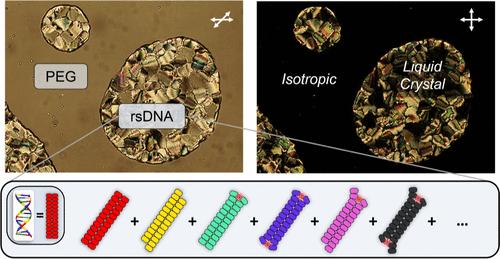随机序列DNA寡聚物制造液晶:一个在超多样化环境中集体排序的案例
IF 16
1区 材料科学
Q1 CHEMISTRY, MULTIDISCIPLINARY
引用次数: 0
摘要
合成、分析和预测工具的可用性使DNA成为研究统计和软物质物理学的理想平台。本文报道并解释了长度为L = 8和L = 12的随机序列DNA (rsDNA)低聚物溶液中的平衡集体顺序。尽管rsDNA溶液中固有的极端分子多样性(L = 12时由2000万个不同的分子物种组成),这些体系在高渗透压下平衡时形成长程柱状液晶(LC)有序。通过实验模型和计算统计的结合,我们证明了rsDNA双链之间的残余端到端吸引力,通常以各种形式的配对误差终止,确实足以驱动LC排序。由此得到的各向同性- lc相共存的窄范围,似乎与组成rsDNA的物质的相行为的多样性形成对比,表明分子相互作用强度的(近乎)连续分布有效地降低了而不是增强了脱混的趋势,这与理论模型一致。本文章由计算机程序翻译,如有差异,请以英文原文为准。

Random-Sequence DNA Oligomers Make Liquid Crystals: A Case of Collective Ordering in a Superdiverse Environment
The availability of synthetic, analytical, and predictive tools makes DNA an ideal platform, not yet considered, to investigate statistical and soft matter physics. Here we report and interpret the equilibrium collective ordering in solutions of random-sequence DNA (rsDNA) oligomers of lengths L = 8 and L = 12. Despite the extreme molecular diversity inherent in rsDNA solutions, which for L = 12 are composed of 20 million distinct molecular species, these systems develop long-range columnar liquid crystal (LC) ordering when equilibrated at high osmotic pressure. By a combination of experimental models and computed statistics, we demonstrate that the residual end-to-end attraction between rsDNA duplexes, which typically terminate with various forms of pairing errors, is indeed sufficient to drive LC ordering. The resulting narrow range of isotropic-LC phase coexistence, in seeming contrast with the variety of phase behaviors of the species composing rsDNA, demonstrates that the (nearly) continuum distribution of molecular interaction strengths effectively reduces the tendency for demixing instead of enhancing it, in line with theoretical modeling.
求助全文
通过发布文献求助,成功后即可免费获取论文全文。
去求助
来源期刊

ACS Nano
工程技术-材料科学:综合
CiteScore
26.00
自引率
4.10%
发文量
1627
审稿时长
1.7 months
期刊介绍:
ACS Nano, published monthly, serves as an international forum for comprehensive articles on nanoscience and nanotechnology research at the intersections of chemistry, biology, materials science, physics, and engineering. The journal fosters communication among scientists in these communities, facilitating collaboration, new research opportunities, and advancements through discoveries. ACS Nano covers synthesis, assembly, characterization, theory, and simulation of nanostructures, nanobiotechnology, nanofabrication, methods and tools for nanoscience and nanotechnology, and self- and directed-assembly. Alongside original research articles, it offers thorough reviews, perspectives on cutting-edge research, and discussions envisioning the future of nanoscience and nanotechnology.
 求助内容:
求助内容: 应助结果提醒方式:
应助结果提醒方式:


